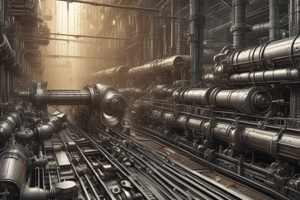Podcast
Questions and Answers
What is the first step in the powder metallurgy process?
What is the first step in the powder metallurgy process?
- Powder production (correct)
- Blending
- Compaction
- Sintering
Which metals are most commonly used in powder metallurgy?
Which metals are most commonly used in powder metallurgy?
- Iron, copper, gold, and silver
- Copper, aluminum, titanium, and iron
- Bronze, stainless steel, tungsten, and lead
- Iron, copper, aluminum, and nickel (correct)
What is the role of gas or water in the atomization process?
What is the role of gas or water in the atomization process?
- To help break the molten metal stream into particles (correct)
- To increase the density of the produced particles
- To provide additional heat to the molten metal
- To cool the molten metal particles rapidly
Which type of atomization uses a rapidly rotating disk to generate particles?
Which type of atomization uses a rapidly rotating disk to generate particles?
What determines the shape and size of particles produced during atomization?
What determines the shape and size of particles produced during atomization?
What is the main purpose of using reducing gases in powder metallurgy?
What is the main purpose of using reducing gases in powder metallurgy?
What characteristic is associated with the powders produced by electrolytic deposition?
What characteristic is associated with the powders produced by electrolytic deposition?
What is the primary purpose of comminution in powder metallurgy?
What is the primary purpose of comminution in powder metallurgy?
What does mechanical alloying primarily involve?
What does mechanical alloying primarily involve?
Why are lubricants added to the metal powders during blending?
Why are lubricants added to the metal powders during blending?
What is a key objective of the compaction process in powder metallurgy?
What is a key objective of the compaction process in powder metallurgy?
Which of the following best describes the term 'green compact'?
Which of the following best describes the term 'green compact'?
What is the role of blending in powder metallurgy?
What is the role of blending in powder metallurgy?
What is the effect of using excessive heat during the blending of powders?
What is the effect of using excessive heat during the blending of powders?
Which statement is true regarding metal carbonyls?
Which statement is true regarding metal carbonyls?
What is the primary purpose of the atomizer in the shape-generation process?
What is the primary purpose of the atomizer in the shape-generation process?
Which chamber in a continuous-sintering furnace is responsible for removing lubricants?
Which chamber in a continuous-sintering furnace is responsible for removing lubricants?
What are the mechanisms involved in sintering metal powders?
What are the mechanisms involved in sintering metal powders?
What is one reason why it is impossible to completely eliminate porosity in sintered materials?
What is one reason why it is impossible to completely eliminate porosity in sintered materials?
What occurs during the liquid-phase sintering of two different metal powders?
What occurs during the liquid-phase sintering of two different metal powders?
Which of the following factors does NOT affect the properties of a sintered compact?
Which of the following factors does NOT affect the properties of a sintered compact?
What is the main purpose of subjecting green compacts to hydrostatic pressure?
What is the main purpose of subjecting green compacts to hydrostatic pressure?
What is the role of the high-temperature chamber in a continuous-sintering furnace?
What is the role of the high-temperature chamber in a continuous-sintering furnace?
What happens as the temperature increases during the sintering process?
What happens as the temperature increases during the sintering process?
In cold isostatic pressing (CIP), what is used to encase the metal powder?
In cold isostatic pressing (CIP), what is used to encase the metal powder?
What is an advantage of powder-injection molding?
What is an advantage of powder-injection molding?
What method is described when metal powder is compacted into a continuous strip?
What method is described when metal powder is compacted into a continuous strip?
What influences the density of a green compact the most?
What influences the density of a green compact the most?
What is the typical temperature range for the injection process in powder-injection molding?
What is the typical temperature range for the injection process in powder-injection molding?
In hot isostatic pressing (HIP), what is used as the pressurizing medium?
In hot isostatic pressing (HIP), what is used as the pressurizing medium?
During the debinding process in powder-injection molding, what happens to the binder?
During the debinding process in powder-injection molding, what happens to the binder?
Flashcards
Powder Metallurgy (PM)
Powder Metallurgy (PM)
A manufacturing process involving the compaction and sintering of metal powders to create solid parts.
Common Metals in PM
Common Metals in PM
Iron, copper, aluminum, tin, nickel, titanium, and refractory metals are frequently used in powder metallurgy.
Blending in PM
Blending in PM
A step in the PM process that creates a uniform mixture of powders.
Compaction in PM
Compaction in PM
Signup and view all the flashcards
Sintering in PM
Sintering in PM
Signup and view all the flashcards
Finishing Operations in PM
Finishing Operations in PM
Signup and view all the flashcards
Atomization in PM
Atomization in PM
Signup and view all the flashcards
Reduction in PM
Reduction in PM
Signup and view all the flashcards
Green Compact
Green Compact
Signup and view all the flashcards
Compaction
Compaction
Signup and view all the flashcards
Hydrostatic Pressing
Hydrostatic Pressing
Signup and view all the flashcards
Cold Isostatic Pressing (CIP)
Cold Isostatic Pressing (CIP)
Signup and view all the flashcards
Hot Isostatic Pressing (HIP)
Hot Isostatic Pressing (HIP)
Signup and view all the flashcards
Powder-Injection Molding
Powder-Injection Molding
Signup and view all the flashcards
Debinding
Debinding
Signup and view all the flashcards
Roll Compaction
Roll Compaction
Signup and view all the flashcards
Metal Carbonyl Production
Metal Carbonyl Production
Signup and view all the flashcards
Comminution
Comminution
Signup and view all the flashcards
Mechanical Alloying
Mechanical Alloying
Signup and view all the flashcards
Blending in Powder Metallurgy
Blending in Powder Metallurgy
Signup and view all the flashcards
Lubricants in Powder Metallurgy
Lubricants in Powder Metallurgy
Signup and view all the flashcards
Binders in Powder Metallurgy
Binders in Powder Metallurgy
Signup and view all the flashcards
Compaction in Powder Metallurgy
Compaction in Powder Metallurgy
Signup and view all the flashcards
What is a powder metallurgy die?
What is a powder metallurgy die?
Signup and view all the flashcards
What is sintering?
What is sintering?
Signup and view all the flashcards
What are the three chambers in a continuous-sintering furnace?
What are the three chambers in a continuous-sintering furnace?
Signup and view all the flashcards
What is diffusion in sintering?
What is diffusion in sintering?
Signup and view all the flashcards
What is vapor-phase transport in sintering?
What is vapor-phase transport in sintering?
Signup and view all the flashcards
What is liquid-phase sintering?
What is liquid-phase sintering?
Signup and view all the flashcards
What is porosity in sintered materials?
What is porosity in sintered materials?
Signup and view all the flashcards
What are post-sintering operations?
What are post-sintering operations?
Signup and view all the flashcards
Study Notes
Chapter 7: Powder Processing
-
Powder metallurgy (PM) is a process that involves metal powders, compacted and then sintered (heated without melting) to form a solid piece.
-
Common metals used in PM include iron, copper, aluminum, tin, nickel, titanium, and refractory metals. Brass, bronze, and steels, often use pre-alloyed powders.
-
PM processing consists of powder production, blending, compaction, sintering, and finishing operations.
Introduction
-
The choice of metal powder production method depends on the desired properties of the final product, including microstructure, bulk and surface properties, chemical purity, porosity, shape, and particle size distribution.
-
Particle sizes produced range from 0.1 to 1000 μm.
-
Different methods yield different particle shapes (acicular, irregular rodlike, flake, dendritic, spherical, irregular, rounded, porous, angular).
Methods of Powder Production
-
Atomization: involves a liquid-metal stream created by injecting molten metal through a small orifice (gas or water atomization). Size and shape depend on molten metal temperature, flow rate, nozzle size, and jet characteristics. Centrifugal atomization uses a rapidly rotating disk or cup to break up the metal stream. Atomization with a rotation consumable electrode involves rapidly rotating the electrode within a helium-filled chamber.
-
Reduction: Uses gases like hydrogen and carbon monoxide as reducing agents to reduce metal oxides to their metallic state. The resulting powders are porous and spongy.
-
Electrolytic Deposition: Uses aqueous or fused salts to produce highly pure metal powders.
-
Carbonyls: Forming carbonyls from iron or nickel reacting with carbon monoxide, then decomposing into pure, spherical metal particles.
-
Comminution: Crushing or grinding brittle or less ductile metals in a ball mill to produce small particles. A ball mill is a machine with a rotating hollow cylinder partially filled with steel or white cast-iron balls.
-
Mechanical Alloying: Mixing powders of two or more pure metals in a ball mill. Impact of balls causes powder fracture and diffusion, forming alloy powders.
Step 2: Blending Metal Powders
-
Blending (mixing) of metal powders is essential for uniform physical and mechanical properties.
-
Additives like lubricants and binders (used in sand molds) improve flow characteristics and facilitate sintering.
-
Powders must be blended under controlled conditions to prevent contamination.
Step 3: Compaction of Metal Powders
-
Blended metal powders are pressed into desired shapes within dies.
-
Compaction aims to achieve the required shape, density, and particle-to-particle contact.
-
Methods: Isostatic pressing (CIP) uses hydrostatic pressure in a flexible rubber mold. Hot Isostatic Pressing (HIP) uses high-temperature inert gases or a vitreous (glasslike) fluid within a high-melting-point metal container. Powder injection molding (PIM) blends fine metal powders with a polymer or wax-based binder. Rolling compacts metal powders into a continuous strip using shaping rolls. Spray Deposition is a shape-generation process that uses atomization and a spray chamber with an inert atmosphere, and a mold to for example produce seamless tubing and pipe. Different compaction methods yield varying properties, like different mechanical and physical properties of the compacted metals.
-
The pressed powder is called a green compact. Higher pressure leads to higher density in the green compact. The size distribution of the particles also impacts the density.
Step 4: Sintering
-
Sintering is the heat treatment of green compacts in a controlled atmosphere furnace to bond individual particles together at a temperature below their melting points.
-
Sintering temperature and time vary with different materials and can be determined by a sintering process chart.
-
Continuous-sintering furnaces usually have three chambers: a burn-off chamber, a high-temperature chamber, and a cooling chamber.
-
Sintering mechanisms are diffusion, vapor-phase transport, and liquid-phase sintering. Liquid-phase sintering occurs when the particles of different metals have varied melting points.
Step 5: Secondary and Finishing Operations
-
operations performed on sintered products to improve properties, dimensional accuracy, and surface finish such as coining and sizing, cold and hot forging or impact forging, and other machining processes (e.g., milling, drilling, tapping).
-
Additional finishing operations such as machining, grinding, plating, and heat treating can further enhance hardness, strength, dimensional accuracy, surface finish, and corrosion resistance in finished P/M products.
-
Impregnation and infiltration reduce porosity in the sintered parts.
Studying That Suits You
Use AI to generate personalized quizzes and flashcards to suit your learning preferences.




